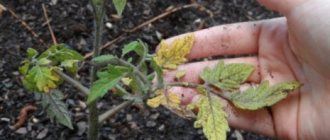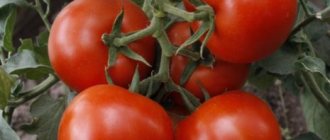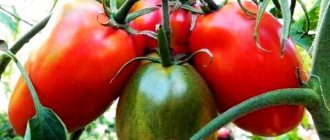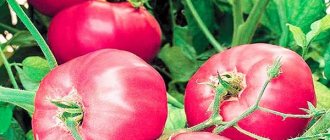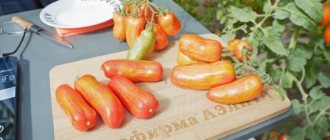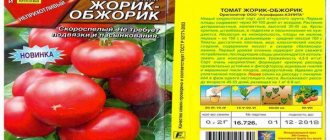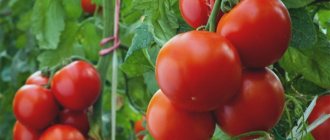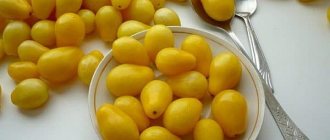Most of us are accustomed to the fact that tomatoes are round in shape and red in color. While the family of this vegetable has numerous species that have different shapes and colors. One of these bright representatives is the Pepper-shaped tomato - it looks and even in cross-section resembles sweet peppers (hence the name).
The Russian hybrid was bred relatively recently (2001) by crossing several varieties, but the basis is the Slivka variety.
Pepper tomatoes can be used both for canning and consumed fresh in salads. They also make excellent tomato juice.
Features and benefits of pepper tomatoes
This variety was derived from plum tomatoes. The fruits are characterized by an elongated shape. In appearance they resemble peppers. The color of the fruit depends on the variety - they are red, yellow, orange.
Many varieties of these tomatoes are indeterminate. They are characterized by unlimited growth. Such plants reach 1.5-2 m in height and can continue to grow further. The plants branch well and have large leaves. Therefore, they need mandatory stepsoning.
Tomatoes have an original elongated shape
The crop can be grown in a greenhouse or in unprotected soil - again, it all depends on the specific variety. The climate of the region in which the gardener is going to grow pepper tomatoes also plays a role.
According to the description, the first brush is formed on the bushes between the 6th and 11th leaves. The next ones are formed every 3 sheets. Each bunch includes up to 6 tomatoes.
Pepper tomatoes are considered mid-season. They bear fruit from July to October. When planting in a greenhouse, this period can be extended. Hybrids can boast excellent yields, and varieties also produce a lot of fruit.
Important! Tomatoes can be eaten fresh or canned. It is permissible to stuff such fruits, since they do not suffer from heat treatment.
The main characteristics of the fruit include the following:
- presence of 2 seed chambers;
- great taste;
- small sizes.
Most fruits are small in size and taste great
Description and characteristics of the variety
This hybrid is divided into several more varieties, each of which has a pepper-shaped shape. The main subspecies was registered in the State Register in 2001.
The height of a tomato bush is from one and a half to two meters. The fruits are collected in clusters containing 7-8 pieces. According to the ripening period, it is mid-early, sometimes it is classified as mid-ripening: 110-115 days pass from seed germination to harvesting the first harvest. The shape of the fruits is elongated and similar to sweet peppers, their color is red (derived hybrids may have yellow and orange tomatoes). Weight on average 80-100 g, length reaches 15 cm. The pulp is fleshy and tasty. There are few seeds inside.
You should not collect seeds, as they will not grow into a plant with the desired characteristics.
It is better to buy hybrid seed from producers. Available on the market:
- Pepper tomato Aelita;
- Chain mail tomato Pepper;
- Tomato Pepper Siberian Garden;
- Tomato Pepper Russian vegetable garden.
All of them are tested for compliance with varietal characteristics and have quality certificates.
The fruits are used in cooking, for preparing fresh salads and canning. They decorate dishes. They are also stuffed; the dense flesh is well suited for this.
Subtleties of cultivation and care
In order for pepper tomatoes to develop well and produce a bountiful harvest, they need to be properly cared for.
Growing and planting seedlings
The time for planting seeds depends on the climate of the region. You can plant tomatoes in the ground after the frosts have ended. It takes 45-65 days to grow seedlings. Accordingly, the gardener, knowing when it becomes warm in the region, should approximately calculate the time for sowing seeds for seedlings.
Pepper-shaped tomato varieties, for the most part, are hybrids and are labeled F1. Therefore, their seeds should be purchased in the store. You can also buy soil or make it yourself. In the second case, it is worth mixing 2 parts of peat, 1 part of turf and compost, 0.5 parts of sand.
Important! You should take a glass of wood ash onto a bucket of substrate. It is also recommended to include the drug with phosphorus, potassium and a small amount of nitrogen.
It is recommended to plant seeds in depressions 2 cm in size. When the first true leaves appear, the tomatoes dive. Seedlings should be grown for 2 months. When 6 leaves appear on the bushes, they can be planted in the ground.
Features of cultivation
The variety “Pepper-shaped orange” is approved for cultivation in all regions of Russia as a variety for open ground and greenhouses. In general, it grows well in open ground, but in a greenhouse the yield will definitely be greater.
In an article about growing tomato seedlings at home, I wrote a lot about the importance of additional illumination of seedlings, stretching, combating stretching, etc. So, seedlings of this particular variety tolerate a lack of light quite well.
When planting in a permanent place, the optimal density is about 3 plants per square meter. I placed them according to a 70 by 50 cm pattern, and this turned out to be a good solution.
It is imperative to plant tomatoes. In open ground in the middle zone - in one stem, in greenhouses you can leave one brush and a leaf behind it on two side stems. It is necessary to tie them up within a couple of weeks after transplantation: the plants do not support their weight even without fruits.
The variety is mid-season: about 114 days pass from the emergence of seedlings to the ripening of the first tomatoes. The yield in a greenhouse is 3...4 kg per plant, which in terms of per square meter is even more than the standard 9 kg/m2. This is a very worthy result.
Plants are affected by late blight in the same way as most other varieties.
Advantages
- suitability for growing in open ground;
- low light requirements when growing seedlings;
- high productivity;
- very beautiful fruits;
- great taste.
Flaws
In essence, there are no shortcomings. Based on the totality of its characteristics, “Pepper Orange” can be considered one of the best tomato varieties for both greenhouses and open ground.
Differences in tomato varieties
There are many varieties of these tomatoes. They differ in color and size of the fruit. Also, bushes can have different stem heights.
- By color
Depending on the variety, tomatoes are red, yellow, or crimson. There are also black, orange, and striped tomatoes.
- By fruit size
Regular tomatoes of this variety are small in size and weigh no more than 150 g.
This is interesting! To get larger tomatoes, plant the Pepper Giant variety. Its fruits reach a weight of 250 g.
- By trunk height
Most pepper tomatoes belong to indeterminate varieties, the height of which reaches 2 m. There are also determinate varieties. They grow up to 0.7-1 m.
How to grow tomatoes
After 2 months, the seedlings are ready for transplanting . The soil for the beds is prepared in advance: it is dug up and compost is added.
Landing
Planting pattern : 60 cm – distance between seedlings, 60 cm – row spacing. For 1 sq. m place no more than 4 plants.
After transplantation, the holes are compacted, watered with warm, settled water and the seedlings are left to get used to the new conditions for 2 weeks. Beds for tomatoes are chosen in a sunny place, protected from drafts.
Reference. During adaptation, the plants are not watered or fed.
Further care
Regular watering is established no more than 2 times a week . On hot and dry days, the amount of watering is increased as the soil dries out. Water with settled water, strictly at the root in the morning or evening. After watering, the soil is loosened, removing weeds with roots. Weeding the beds is mandatory, since the weeds are home to a large number of pests and pathogenic spores.
To retain moisture in the beds, they are mulched with peat or straw . Sawdust can also be used as mulch. Mulching your beds not only helps the soil stay moist longer, but also serves as a preventive measure in the fight against pests.
The first feeding is carried out 2 weeks after transplanting the seedlings . Fertilize with a small amount of superphosphate. With slow growth, seedlings are fed with a full range of mineral fertilizers containing mainly nitrogen.
The second feeding is given 3 weeks after the first . Organic matter is used as fertilizer, for example, mullein infusion in a ratio of 1:10. If there is an increased growth of green mass, fertilizing should be based on phosphorus substances.
The third feeding is applied at the time of fruit formation . Plants are fed with a full range of mineral fertilizers.
Reference. During flowering, wood ash is used as additional fertilizing.
Features of cultivation and possible difficulties
To obtain the maximum fruiting rate, the bushes are formed into 2 or 3 stems . All other stepsons are regularly removed, not allowing them to grow more than 5 cm, otherwise the sections will take much longer to heal. They do this in the morning so that the wounds have time to heal by evening. To avoid the development of infections, the cut sites are treated with a weak solution of manganese.
Tall bushes must be tied up , otherwise the stem will not support the weight of the fruit-bearing branches. When transplanting, a wooden or metal support is installed next to each seedling, to which the stem is fixed. As they grow, fruitful branches are also tied to a support.
Diseases and pests
The culture is resistant to major diseases , but if preventive measures are taken, the immune system is strengthened even more. Prevention includes systematic loosening, removing weeds, mulching beds and ventilating closed structures. Before planting tomatoes, the beds are treated with copper sulfate, which reliably protects against the spread of fungal spores. At the initial stage of development, plants are sprayed with the drug “Fitosporin”, which protects the crop from many infections.
To control pests, chemicals are used only before flowering and only when there is a large concentration of insects. If there are few pests, you can get by with folk remedies.
These methods include spraying plants with decoctions of onion, garlic and plantain peels. Treatment protects against many ground and flying parasites. Placed pheromone traps will protect bushes from whitefly invasion. A thorough daily inspection of plants will protect you from the Colorado potato beetle. The beetle is collected by hand and burned in glass jars.
Read also: What to plant along the greenhouse
Advantages and disadvantages
Tomatoes with pepper-shaped fruits are endowed with a number of advantages. The main ones:
- A plant with strong immunity. Read more about tomato diseases here.
- Fruiting is extended. Tomatoes are harvested starting in mid-summer and ending before frost.
- The hybrid has many varieties. Every gardener has no problem choosing the option that suits the conditions on his site.
- High yields. On average, the bush brings 3.5-4 kg.
- The tomato is very tasty. The pulp is crumbly, sweet with sourness. Not many seeds.
- The tomatoes are in marketable condition and can withstand transportation without any problems.
The disadvantage is the high cost of planting material. The gardener himself cannot obtain good seeds, since the tomato is not a pure variety.
Attention! In cool regions, a decent harvest of pepper fruits is obtained only in greenhouses.
Transplanting tomatoes into open ground
Tomatoes love a sunny place protected from the winds. Since this variety belongs to the group of tall plants, it is necessary to provide a trellis system for gartering the stem.
Before planting, the soil must be prepared. It is recommended to apply 4 kg of manure per 1 m2 of soil to the prepared area in autumn and spring.
Planting seedlings in the ground is carried out according to the 70x50 cm pattern
Planting is carried out at the rate of 3-4 plants per 1m2 or according to a 70x50 cm pattern. In this case, tomatoes can be formed into two stems. If the planting is denser, then the stem is left alone. Holes with dimensions of at least 15x15 and a depth of a shovel bayonet are prepared for planting.
